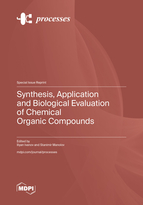Synthesis, Application and Biological Evaluation of Chemical Organic Compounds
A special issue of Processes (ISSN 2227-9717). This special issue belongs to the section "Chemical Processes and Systems".
Deadline for manuscript submissions: closed (25 August 2023) | Viewed by 25997
Special Issue Editors
Interests: organic chemistry; synthesis; heterocycles
Special Issues, Collections and Topics in MDPI journals
Interests: green synthesis; heterogeneous cyclisation; isoquinolines; profens
Special Issues, Collections and Topics in MDPI journals
Special Issue Information
Dear Colleagues,
The process of the transformation of one molecule into another molecule, which involves building new chemical bonds and breaking existing ones, is of great importance in organic synthesis. The main task of organic synthesis is the obtainment of a variety of organic compounds—both isolated in minimal quantities from natural products and unknown organic molecules, or compounds with certain biological, or other predetermined properties, based on suitable starting materials using various synthetic processes. In essence, organic synthesis is a complex methodology for building organic molecules from individual starting materials, fragments, or synthons. This task is performed by appropriately selected organic reactions, which lead to the production of certain reaction products and ultimately to the target molecules.
Recently, during and before the pandemic of novel SARS-CoV-2, a large number of new organic hybrid molecules were developed using known and newly invented synthetic methodologies, some of which showed outstanding results in the treatment against COVID-19.
With this Special Issue on “Synthesis, Application and Biological Evaluation of Chemical Organic Compounds”, we aim to attract original research articles and review papers that cover research on the synthesis of new organic molecules using newly developed or known synthetic procedures, the evaluation of their biological evaluation, and their application.
In this Special Issue, original research articles and reviews are welcome. Research areas may include (but are not limited to) the following:
- The development of new procedures for the obtainment of organic compounds;
- The synthesis of new organic molecules;
- The synthesis of hybrid molecules;
- The synthesis and biological evaluation of new molecules;
- In silico, in vitro, and in vivo biological evaluation of new and/or known organic compounds.
We look forward to receiving your contributions.
Prof. Dr. Iliyan Ivanov
Dr. Stanimir Manolov
Guest Editors
Manuscript Submission Information
Manuscripts should be submitted online at www.mdpi.com by registering and logging in to this website. Once you are registered, click here to go to the submission form. Manuscripts can be submitted until the deadline. All submissions that pass pre-check are peer-reviewed. Accepted papers will be published continuously in the journal (as soon as accepted) and will be listed together on the special issue website. Research articles, review articles as well as short communications are invited. For planned papers, a title and short abstract (about 100 words) can be sent to the Editorial Office for announcement on this website.
Submitted manuscripts should not have been published previously, nor be under consideration for publication elsewhere (except conference proceedings papers). All manuscripts are thoroughly refereed through a single-blind peer-review process. A guide for authors and other relevant information for submission of manuscripts is available on the Instructions for Authors page. Processes is an international peer-reviewed open access monthly journal published by MDPI.
Please visit the Instructions for Authors page before submitting a manuscript. The Article Processing Charge (APC) for publication in this open access journal is 2400 CHF (Swiss Francs). Submitted papers should be well formatted and use good English. Authors may use MDPI's English editing service prior to publication or during author revisions.







